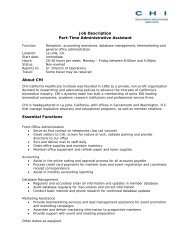California Biomedical Industry - California Healthcare Institute
California Biomedical Industry - California Healthcare Institute
California Biomedical Industry - California Healthcare Institute
You also want an ePaper? Increase the reach of your titles
YUMPU automatically turns print PDFs into web optimized ePapers that Google loves.
Through the first decade of this century,analysts looked at healthcare deliveryin the United States and consistentlyfound shortages of doctors and nurses,especially in rural or blighted urbanareas. They also predicted imminentcrises in specialty practices, such asgerontology.“When you have money,” said John D.Stobo, MD, senior vice president forhealth sciences and services for theUniversity of <strong>California</strong> (UC), “you buildmore medical schools and create morenursing programs” to correct a shortageof healthcare workers.“When money is an issue,” hecontinued, “you look at the situationmore pragmatically.” If people can’tget the care they need, the underlyingproblem may not necessarily be ashortage of doctors or nurses. “Theproblem is access to healthcare,” Stobosaid.Stobo cited the <strong>California</strong> TelehealthNetwork (CTN) as a technology-drivensolution that is more effectively andefficiently filling the need for healthcareaccess to those who live in <strong>California</strong>’srural areas. Led by the Center forInformation Technology Research inthe Interest of Society (CITRIS) andresearchers at the UC Davis MedicalCenter, CTN is a groundbreakingstatewide “medical grade” network. Itlinks 863 sites throughout <strong>California</strong>— hospitals, teaching and researchinstitutions, clinics, and other providers— for patient care and research usingtelehealth technology. The systemenables a few specialists to servepatients across large geographic areas,something they could not physicallymanage.In 2007, Gov. Arnold Schwarzeneggerasked the University of <strong>California</strong> toserve as the lead agency in developingand managing the CTN project. On Aug.17, 2010, the governor and U.S. ChiefTechnology Officer Aneesh Chopralaunched the network at the UC DavisCancer Center in Sacramento. Thenetwork is the result of a $30 millionjoint funding effort between the FederalCommunications Commission (FCC),the <strong>California</strong> Emerging TechnologyFund (CETF), the <strong>California</strong> HealthCareFoundation, United<strong>Healthcare</strong>, theNational Coalition for <strong>Healthcare</strong>Integration, the University of <strong>California</strong>and other private and public entities.In such large initiatives as CTN,Stobo said, UC is able to leverage itstechnology, ingenuity and connectionsto put together effective teams and tobring projects to fruition. As part ofthe CTN development, UC establishedthe 501(c) organization responsible foroperating the network going forward,freeing UC Davis’ health IT experts totackle other public health challenges.Stobo’s story does more than illustratethe enormous role that the UC systemplays in addressing systemic societalchallenges. The example also serves asan analogy for the UC system itself.For most of its history, the UC systemhas had money. It first opened its doorsin 1869 with 10 faculty members and 38students. Today, the UC system includesmore than 220,000 students and morethan 170,000 faculty and staff on 10campuses (see sidebar page 67).All of the system’s resources, facilitiesand programs, however, have beenunder extreme stress since thefinancial crisis began in 2007. Facinga $24 billion budget deficit in 2009-2010, <strong>California</strong> made drastic cuts toits education, healthcare and socialservices. That was a debilitating turnfor the state’s educational institutions,which depend on the state for theirlargest single source of salary funding.UC received 20 percent less statefunding for fiscal year 2009-2010 thanit had just two years earlier, leavinga budget shortfall of $813 million.Approximately 100,000 nonunion UCemployees had their pay cut throughunpaid furlough days, starting Sept. 1,2009. The furloughs amounted to payreductions of between 4 percent and 10percent, depending on the employee’ssalary range. In addition to cuttingprograms, staff and faculty recruitment— and reducing freshmen enrollmentby 6 percent — the UC system raisedstudent fees by 9.3 percent for the2009-2010 school year. The regentsapproved an additional 3.2 percentincrease in student fees to be fully inplace by the fall 2010 term.The crisis is not over. The statecontinues to face budget deficits withno obvious permanent solutions. Forfiscal year 2010-2011, UC anticipatesa budget gap of $1 billion. The UCRegents approved an additional 8percent tuition and fee increase inNovember 2010. The increase of$822 for all UC students will raise theundergraduate cost to $11,124 per year(a system-wide average of $12,150 whenindividual campus fees are included).Other 2010-2011 cost-cutting measureshave included a paring down of theOffice of the President, an action thatis part of system-wide administrativereforms that could save $500 millionannually. UC has restructured debt,cancelled some bonus and incentiveprograms, cut energy use on itscampuses, implemented staff reductionsand continued to reduce course andprogram offerings.For longer-term solutions, the systemin 2009 formed a Commission onthe Future. The commission’s fivework groups assessed the size andshape of the system, its education andcurriculum, access and affordability,and funding and research strategies.The commission found that UCcontinues to meet its 1960 Master Planfor Higher Education obligations toprovide a place for <strong>California</strong> residentsin the top one-eighth of each graduatinghigh school class and spots for eligiblestate community college transferstudents. At the same time, the boardoffered recommendations (see sidebarpage 67) to help the university preserve<strong>California</strong> <strong>Biomedical</strong> <strong>Industry</strong> 2011 Report | 55






